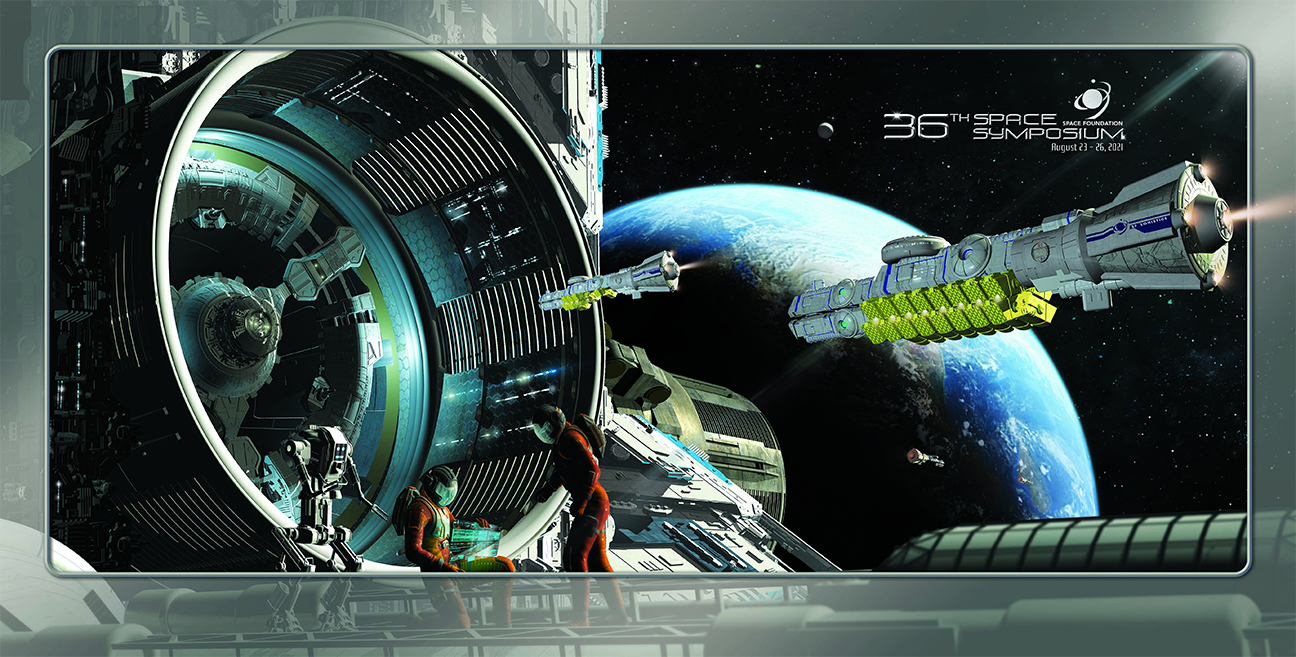AFRL to showcase space-related technologies and SpaceWERX at 36th National Space Symposium
WRIGHT-PATTERSON AIR FORCE BASE, Ohio (AFRL) – The Air Force Research Laboratory will showcase several space-related technologies, new ways to connect with and share an idea or capability with AFRL, and the beginning of SpaceWERX, the U.S. Space Force affiliated arm of AFWERX during the 36th Space Symposium in Colorado Springs, Colorado, Aug. 23-26, 2021.
AFRL supports both the U.S. Air Force and U.S. Space Force with Airmen and Guardians, seamlessly working high priority research areas across the lab’s technology directorates to move research to meet operational needs even faster.
Some of the technologies to be highlighted by AFRL include development of two Department of the Air Force Vanguard programs with a space focus: Navigation Technology Satellite 3 (NTS-3) and Rocket Cargo.
NTS-3 demonstrates next generation positioning, navigation and timing technologies for a more flexible, robust, and resilient architecture for satellite navigation technology. It also allows AFRL scientists to test reprogrammable software-defined receivers that are able to rapidly respond to new conditions and ensure better security and flexibility.
Rocket Cargo aims to develop the capability to lease a commercial rocket to deliver 50-100 tons of DOD cargo anywhere on the planet in less than one hour and to prove that rocket-based terrestrial cargo transportation is viable, affordable and advantageous for agile global DOD logistics.
The Space Solar Power Incremental Demonstrations and Research Project (SSPIDR): Space Power Beaming, is a series of integrated demonstrations and technology maturation efforts that will address space-based power collection and transmission capabilities, and mature technology critical to building an operational solar power transmission system for providing reliable and logistically agile power for expeditionary forces.
Arachne, the keystone flight experiment in SSPIDR, aims to demonstrate the ability to collect, convert, and beam energy to the ground, collect solar energy using high-efficiency solar photovoltaic cells, then convert it to RF energy using the revolutionary sandwich tile, and beam it to a receiving station on the ground, and rectify and convert the RF energy into usable power for use by U.S. warfighters and end users.
Rocket-Factory-in-a-Box is a program to develop a mobile, containerized Solid Rocket Motor production capability by aggregating revolutionary design and component manufacturing techniques and enabling rapid SRM manufacture in a small footprint with the flexibility to tailor performance to specific missions.
SpaceWERX, the U.S. Space Force-affiliated arm of the AFWERX team, focuses on advancing innovative technologies for USSF Guardians and expanding the space industrial space by guiding additional partners, leveraging commercial investment and rapidly pursuing new technologies, while closely aligning its efforts with space operators and acquisition professionals within the USSF.
Innovators who would like to share ideas with AFRL, are encouraged to visit the Air Force and Space Force Tech Connect website, a portal where users can submit ideas and capabilities with AFRL subject matter experts for potential feedback, collaborations and opportunities. Learn more about this tool and discover other avenues for engaging with AFRL at the 36th National Space Symposium.
Maj. Gen. Heather Pringle, AFRL commander, is scheduled as a featured speaker on Aug. 26 and will deliver her presentation, “One AFRL, Two Services,” from 9:50 a.m. – 10:05 a.m.
“Our way of warfare depends on space superiority and AFRL has a long history of research and development in support of this domain,” said Pringle. “With the recent standup of the USSF, along with the emergence of U.S. Space Command and new energy in the commercial space sector, we have exciting opportunities to modernize the way we lead and manage science and technology.”
“Having one science and technology research laboratory for our nation’s aerospace forces allows AFRL to fully implement the Air Force Science & Technology Strategy on behalf of the entire Department of the Air Force, which aims to build a force capable of dominating across time, space, and complexity in all domains to ensure we continue to have the advantage in future conflicts,” said Timothy Sakulich, AFRL executive director.
“Space as a warfighting domain is not a passing phase – it is a lasting reality,” said Dr. Kelly Hammett, AFRL’s deputy technology executive officer for Space. “The USSF is mission focused and dedicated to further accelerating U.S. space capabilities to enhance our lethality and readiness, and to ensure our nation is prepared to fight and win in a war that starts in, or extends to, space,” Hammett said.
For more information about the 36th Space Symposium, please visit www.spacesymposium.org.
NOTE FOR MEDIA: Please contact Bryan Ripple, AFRL’s Media Operations team lead, at bryan.ripple@us.af.mil to request an interview opportunity to discuss these technology exhibits, and learn more about these efforts.

The Air Force Research Laboratory will showcase several space-related technologies, new ways to connect with and share an idea or capability with AFRL, and the beginning of SpaceWERX, the U.S. Space Force affiliated arm of AFWERX during the 36th Space Symposium in Colorado Springs, Colorado, Aug. 23-26, 2021. (Courtesy graphic)
